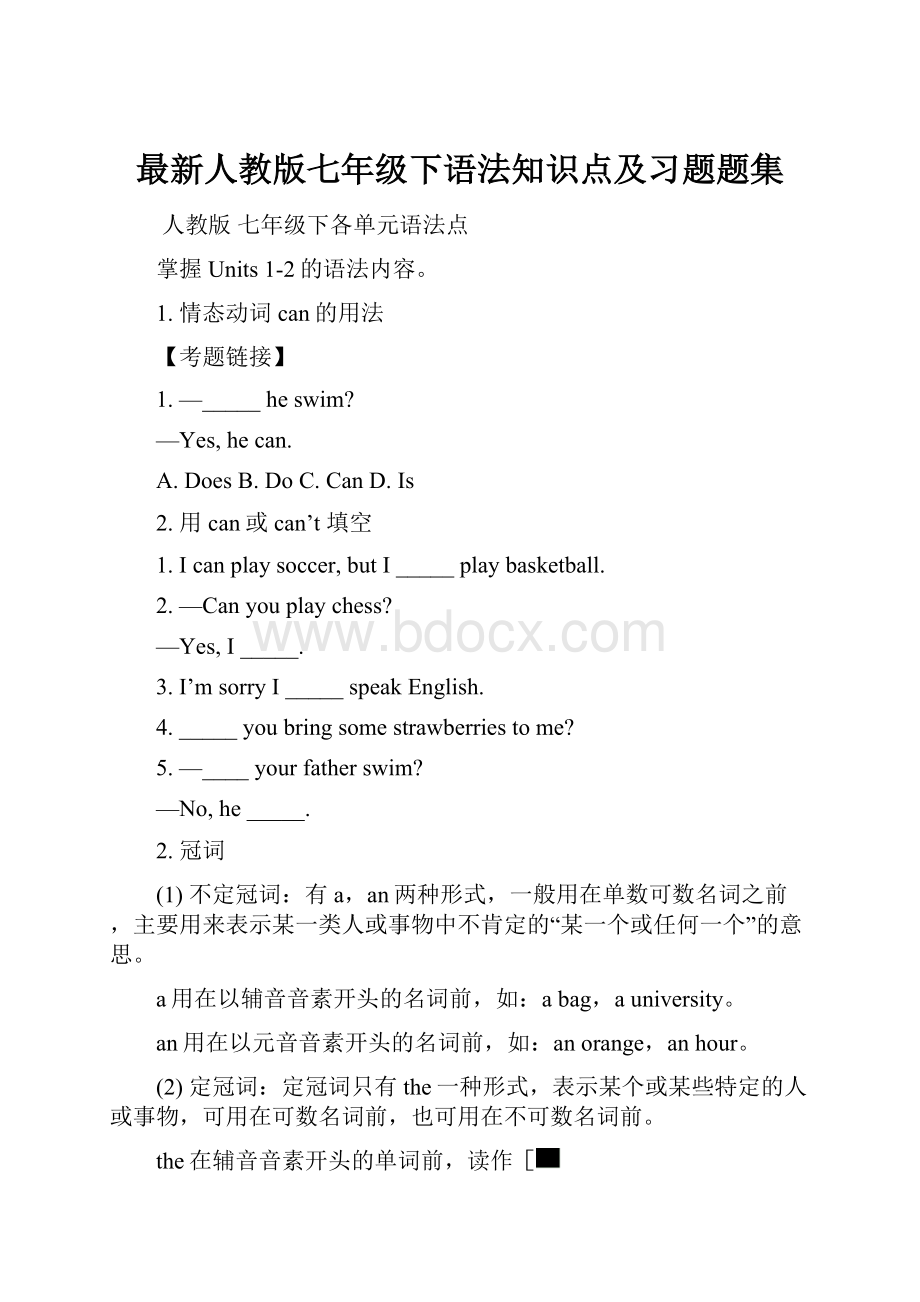 最新人教版七年级下语法知识点及习题题集.docx
最新人教版七年级下语法知识点及习题题集.docx
- 文档编号:9553907
- 上传时间:2023-02-05
- 格式:DOCX
- 页数:29
- 大小:58.69KB
最新人教版七年级下语法知识点及习题题集.docx
《最新人教版七年级下语法知识点及习题题集.docx》由会员分享,可在线阅读,更多相关《最新人教版七年级下语法知识点及习题题集.docx(29页珍藏版)》请在冰豆网上搜索。

最新人教版七年级下语法知识点及习题题集
人教版七年级下各单元语法点
掌握Units1-2的语法内容。
1.情态动词can的用法
【考题链接】
1.—_____heswim?
—Yes,hecan.
A.DoesB.DoC.CanD.Is
2.用can或can’t填空
1.Icanplaysoccer,butI_____playbasketball.
2.—Canyouplaychess?
—Yes,I_____.
3.I’msorryI_____speakEnglish.
4._____youbringsomestrawberriestome?
5.—____yourfatherswim?
—No,he_____.
2.冠词
(1)不定冠词:
有a,an两种形式,一般用在单数可数名词之前,主要用来表示某一类人或事物中不肯定的“某一个或任何一个”的意思。
a用在以辅音音素开头的名词前,如:
abag,auniversity。
an用在以元音音素开头的名词前,如:
anorange,anhour。
(2)定冠词:
定冠词只有the一种形式,表示某个或某些特定的人或事物,可用在可数名词前,也可用在不可数名词前。
the在辅音音素开头的单词前,读作[
];而在元音音素开头的单词前,读作[
]。
【考题链接】
1._____boyunderthetreeis____goodstudent.
A.The;aB.A;theC.A;aD.The;the
2.Hehas_____cat.____catisverycute.
A.a;AB.the;TheC.a;TheD.the;A
3.Ihopewecanflyto____moononeday.
A.aB.anC.theD./
4.____Wangsmovedtoanewhouselastweek.
A.AB.TheC./D.An
5._____youngshouldtakecareof_____old.
A.A;anB.The;anC.The;theD.A;the
6.—What’sinyourbag?
—______Englishbookisinit.
A.AB.AnC.TheD./
7.—Whichoneisyourdaughter,Mr.White?
—Oh,thatlittlegirlin_____orangejacket.
A.aB.anC./D.some
8.______elephantis_____usefulanimal.
A.A;anB.An;aC.An;anD.A;a
9.Ihave_____eggand_____hamburgerforbreakfast.
A.an;theB.the;aC.the;theD.an;a
10.Hewantstohave______secondtry.
A.aB.anC.theD./
11._____Brownswerehavingdinnerwhenthetelephonerang.
A.AB.AnC.TheD./
12.It’sreportedthataterriblerainstormhit_____southofourcountry.
A.aB.theC./D.an
13.Of_____two,sheis_____cleverer.
A.a;theB.the;theC./;theD.the;/
14.____olderheis,_____happierhefeels.
A.The;aB.An;theC.An;aD.The;the
15.Hewasbornin______summerof1970.
3.不用冠词的情况
1.Whatisinyour______otherhand?
A.aB.anC.theD./
2.—WhendoyouhaveP.E.?
—On_____TuesdayandFriday.
A.theB.aC.anD.
3.Hecan’tplay______football,buthecanplay______piano.
A.the;theB.a;aC./;theD.the;/
4.Ilike_____sciencebestofallthesubjects.
A.aB.anC.theD./
5.Doyougotoschoolby______bike?
A.theB./C.aD.an
6.Heisillin______hospital.Hisfatherisin______hospitaltolookafterhim.
A.a;aB.an;anC.the;/D./;the
4.时间的表达法
(1)整点的表达法:
当时间是整点时,可以用钟点数或在钟点数后加o’clock来表达。
8:
00表示为:
eight/eighto’clock
(2)不整点的表达法:
①钟点数+分钟数表达法
8:
25表示为:
eighttwenty-five
②分钟数+to/past+钟点数表达法
A.30分钟(包括30分钟)以内,用“分钟数+past+钟点数”表达。
7:
15表示为:
fifteenpastseven
5:
28表示为:
twenty-eightpastfive
B.30分钟以上,用“(60-分钟数)+to+下一个钟点数”表达。
7:
55表达为:
fivetoeight
【考题链接】
写出下列时间的表达
1.7:
30_______________或_______________
2.11:
45_______________或_______________
3.9:
10_______________或_______________
掌握Units3-4的语法内容
一、how引导的特殊疑问句
【用法1】
how引导的特殊疑问句,可用来询问做某事的方式或方法,也可用来询问某人或某物的状况。
①howold多大,提问年龄。
②howmany多少,提问可数名词的量。
③howmuch多少,提问不可数名词的量。
多少钱;提问价格。
④howlong多长时间,提问一段时间。
多长,提问物体的长度。
⑤howfar多远,提问距离。
【考题链接】
1.—____isittothetrainstation?
—Aboutsixkilometers.
A.HowlongB.HowfarC.HowmuchD.Howoften
2.—______doyoulivehere?
—Foraboutfivemonths.
A.HowmuchB.HowoftenC.HowlongD.Howfar
3.—_____arethesocks?
—They’re10yuan.
A.HowoldB.HowmuchC.HowsoonD.Howmany
对画线部分提问
2.Ittakesme15minutestowalktoschool.
____________it____youtowalktoschool?
3.It’sthreemilesfrommyhometoschool.
________isitfromyourhometoschool?
4.Igotoschoolbycar.
________yougotoschool?
5.Isleepninehourseverynight.
_____________doyousleepeverynight?
6.Hissonis11yearsold.
________ishisson?
7.Theboywillfinishhishomeworkin2hours.
__________willtheboyfinishhishomework?
8.Iwanttwoglassesofmilk.
__________milkdoyouwant?
9.Ithinkthebookisinteresting.
_____doyou_____thebook?
10.Myskirtis20dollars.
__________isyourskirt?
二、祈使句的用法
1.定义
用来表示请求、命令、建议、号召、警告等的句子。
说话的对象大多为第二人称you,且常被省略。
句末用感叹号或句号,读时用降调。
为了表示客气,常用please一词。
放在句首时,其后不加逗号;放在句末时,其前通常加逗号。
2.构成
祈使句分为肯定祈使句和否定祈使句。
(1)肯定祈使句的构成:
①Do型,即以行为动词原形开头。
②Be型,即以动词be开头。
Bequietplease!
请安静!
③Let型,即以let开头。
Let’splaybasketball.让咱们去打篮球吧
(2)否定祈使句的构成:
①Do型和Be型的否定式,在动词前加don’t或never。
Don’tcomein.不要进来。
Neverbeangry.绝不生气。
②Let型的有两种否定形式:
在let前加don’t或在letsb.后加not。
Don’tletthemcry.=Letthemnotcry.不要让他们哭。
Letmenotgothere.=Don’tletmegothere.不要让我去那儿。
③No+v.-ing形式/名词,用于警示人们不要做某事。
3.答语
祈使句的动作通常是将来发生的动作,所以回答祈使句时,一般用will或won’t。
【注意】
在回答具有否定意义的祈使句时,要注意形式一致和意义相反。
即:
yes与will;no与won’t要一致;yes意为“不”;no意为“是”。
【例句】
—Don’tgoout.It’sraininghard.不要出去了。
天正下着大雨。
—Yes,Iwill.Lilyiswaitingforme.不,我要去。
莉莉在等我呢
4.注意
祈使句和陈述句的连用
祈使句与陈述句连用,有两种形式:
(1)祈使句+and/then+陈述句,二者之间表示一种顺承关系。
【例句】
Studyhard,andyoucangetgoodgrades.努力学习,你就会取得好成绩。
(2)祈使句+or+陈述句,二者之间表示一种否定条件
【考题链接】
1.Please_____theblackboard.
A.lookB.lookatC.tolookD.tolookat
2.LetLily______piano.
A.playB.toplayC.toplaytheD.playthe
1.______lateforschool.
A.NotbeB.NotisC.Don’tbeD.Don’tis
2.______smoking!
A.NotB.Don’tC.NoD.Doesn’t
—Peter,don’tsteponthegrass.
—______.
A.Itdoesn’tmatterB.Ican’tdoit
C.Don’tworryD.Sorry,Iwon’tdoitagain
Hurryup,_____youwillmisstheearlybus.
A.orB.andC.soD.but
句型转换
1.Youmustcomehereearlytomorrow.(改为祈使句)
_____hereearlytomorrow!
2.Lookatthepicture!
(改为否定句)
__________atthepicture!
3.Letherhelpyou.(改为否定句)
__________herhelpyou.
4.Youcan’tbelatenexttime.(改为祈使句)
___________latenexttime.
5.Youcandrinkandeatinthedininghall.(改为否定祈使句)
_____drink_____eatinthedininghall.
三、情态动词haveto,must
1.haveto意为“不得不”,强调客观需要,能用于多种时态。
本身有第三人称单数形式hasto。
【考点1】
一般现在时态中,haveto的否定句要借助助动词don’t/doesn’t,再加haveto。
【例句】
Youdon’thavetocomeheresoearly.你不必那么早来这儿。
【考点2】
一般现在时态中,haveto的一般疑问句要借助于助动词do/does放在开头,后接haveto
【考点3】
一般现在时态中,特殊疑问句是:
特殊疑问词+do/does+主语+haveto+其他?
2.must意为“必须;应当”,表示义务、命令或必要。
强调主观看法,没有时态变化。
否定式mustn’t表示“禁止,严禁”。
【考点4】
以must开头的一般疑问句,简略肯定回答用must,简略否定回答用needn’t或don’thaveto。
needn’t相当于don’thaveto,意为“不必”。
【例句】
—MustIdothedishestoday?
我今天必须洗餐具吗?
—Yes,youmust./No,youneedn’t/don’thaveto.是的,必须。
/不,你不必。
【考题链接】
It’stoolate.We_____gohome.
A.canB.havetoC.mayD.must
1.—MayIgotothecinema,Mom?
—Certainly.Butyou_____bebackby11o’clock.
A.canB.mayC.mustD.need
2.—Dad,mustIfinishmyhomeworktoday?
—No,you_____.Youmaydoittomorrow.
A.needn’tB.mustn’tC.don’tD.won’t
句型转换
1.Hehastoeatinthedininghall.(改为否定句)
He__________toeatinthedininghall.
2.Wemustbeontime.(改为一般疑问句)
_____we______ontime?
3.Billhastolistentothemusicoutside.(改为一般疑问句)
_____Bill_____tolistentothemusicoutside?
4.—Musttheyfollowtherules?
(作否定回答)
—_____,they_____.
5.Thestudentshavetoreadbooksinthemorning.(对画线部分提问)
___________thestudents_____toreadbooks?
掌握Units5-6的语法内容。
1.why引导的特殊疑问句
疑问词why意为“为什么”,用来询问原因。
why引导的特殊疑问句的结构为:
疑问词Why+一般疑问句?
why引导的特殊疑问句,常用because引导的句子回答。
【例句】
—Whydoyoulikeelephants?
你为什么喜欢大象?
—Becausethey’reveryinteresting.因为它们很有趣。
【注意】
because和so不能用在同一个句子中,二者只能取其一。
【考题链接】
1.—_____doesshegotoseethekoalas?
—Becausethey’resmartandfriendly.
A.WhatB.WhereC.HowD.Why
2._____lionsareveryscary,_____Idon’tlikethem.
A.Because;soB.So;becauseC.Because;/D./;because
【即学即练】
句型转换
1.Julielikeskoalasbecausethey’reinteresting.(对画线部分提问)
__________Julie_____koalas?
2.PandasarefromChina.(同义句转换)
Pandas__________China.
3.Whydoyoulikecats?
(用cute来回答)
_______________.
4.to,why,you,want,do,see,the,bears(连词成句)
________________________________________
5.like,I,because,they,are,very,lovely,pandas(连词成句)
_____________________________________
2.形容词在句中的位置和充当的成分
【考点1】
形容词在句中的位置
(1)形容词在句中一般用来修饰名词,常放在名词之前。
(2)形容词也可作系动词的表语,即放在系动词之后。
(3)当形容词作定语修饰不定代词something,anything,nothing等时,要放在被修饰词的后面。
【考点2】
形容词充当的成分
(1)作定语,修饰/限定名词/代词
(2)作表语
形容词作表语,与be动词或其他连系动词连用,说明主语的情况。
(3)作宾语补足语
形容词作宾语补足语,用来补充说明宾语。
【考题链接】
1.Ihave_____totellyou.
A.nothinggoodB.goodnothingC.goodthingD.thinggood
2.Graceisa_____girl.Shedoesn’tlikemeetingnewfriends.
A.smartB.shyC.strictD.cute
【即学即练】
把下列短语翻译成英语
1.一只小猫___________
2.三只害羞的大熊猫___________
3.五头友好的大象___________
4.两头懒惰的狮子___________
5.四只恐怖的老虎____________
6.七只美丽的长颈鹿___________
7.十只可爱的树袋熊___________
8.八只聪明的动物____________
9.新的事情___________
10.困难的事情___________
3.现在进行时态
【考点1】
基本用法:
(1)表示现在(说话瞬间)正在进行或发生的动作。
(2)表示当前一段时间的活动或现阶段正在进行的动作。
【考点2】
句式
(1)否定句:
be后加not;
(2)一般疑问句:
be在主语前,且首字母大写,句末加问号。
一般疑问句的简略肯定回答:
Yes,主语+be。
简略否定回答:
No,主语+benot。
【考点3】
现在分词的构成:
(1)一般情况下,直接在动词末尾加-ing,如:
play→playing
(2)以不发音的e结尾的动词,先去e再加-ing,如:
come→coming
(3)以重读闭音节结尾的动词,且末尾只有一个辅音字母,先双写末尾的辅音字母,再加-ing,如:
swim→swimming
(4)以ie结尾的动词,将ie变为y,再加-ing,如:
lie→lying
【考点4】
常用的标志词:
(1)句中有now时,常表示动作正在进行。
(2)当句首有提示性动词look,listen等时,说明动作正在进行。
(3)根据语境或上下文来判断。
【考点5】
现在进行时和一般现在时的区别:
概念不同
感情色彩不同
谓语动词形式不同
现在进行时
表示此时此刻或现阶段正在进行的动作。
表示的动作可带有
感情色彩。
助动词be+v-ing形式。
一般现在时
表示经常性或习惯性
的动作或状态。
所表示的动作通常是事实。
系动词和实义动词
【考题链接】
1.Thechildren____kitesintheparknow.
A.makingB.makesC.ismakingD.aremaking
。
2.—IsyoursisterwatchingTVnow?
—____.
A.Yes,sheisB.Yes,shedoesC.No,sheisD.She’swatchingTV
3.Look!
Theoldman____underthebigtree.
A.talksB.talkC.aretalkingD.istalking
4.—____?
—He’sswimmingatthepool.
A.WhatdoesTomdoB.IsTomswimming
C.WhatisTomdoingD.
- 配套讲稿:
如PPT文件的首页显示word图标,表示该PPT已包含配套word讲稿。双击word图标可打开word文档。
- 特殊限制:
部分文档作品中含有的国旗、国徽等图片,仅作为作品整体效果示例展示,禁止商用。设计者仅对作品中独创性部分享有著作权。
- 关 键 词:
- 新人 教版七 年级 语法 知识点 习题
 冰豆网所有资源均是用户自行上传分享,仅供网友学习交流,未经上传用户书面授权,请勿作他用。
冰豆网所有资源均是用户自行上传分享,仅供网友学习交流,未经上传用户书面授权,请勿作他用。


 《城市规划基本知识》深刻复习要点.docx
《城市规划基本知识》深刻复习要点.docx
 SQLSever数据库管理系统.ppt
SQLSever数据库管理系统.ppt
